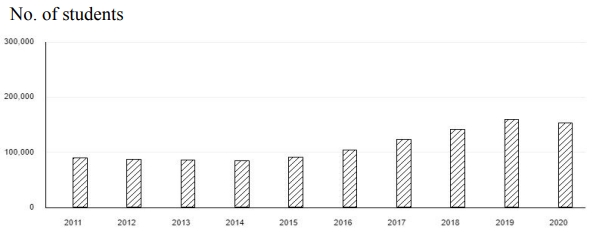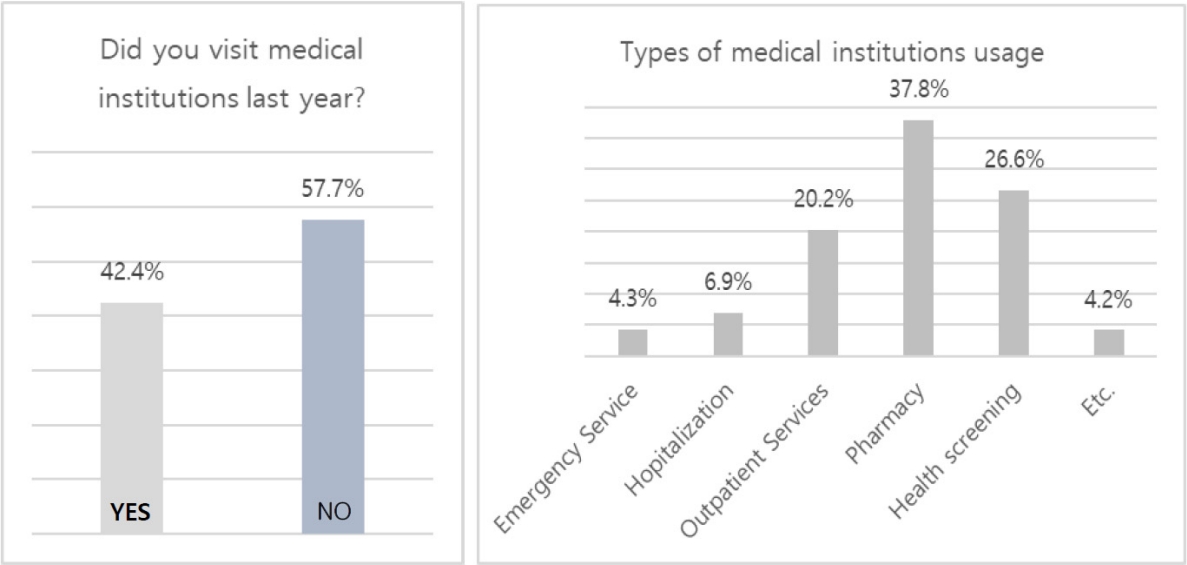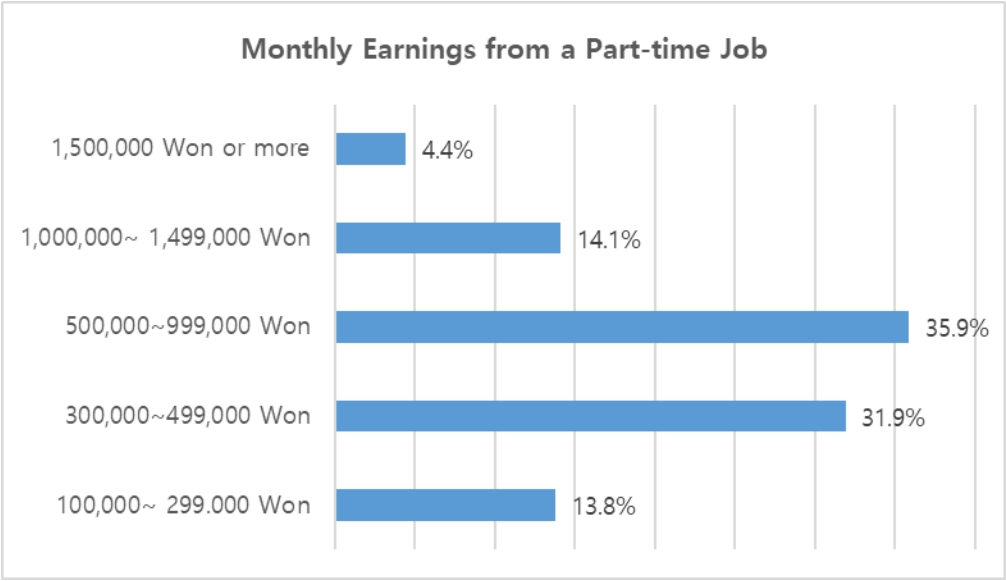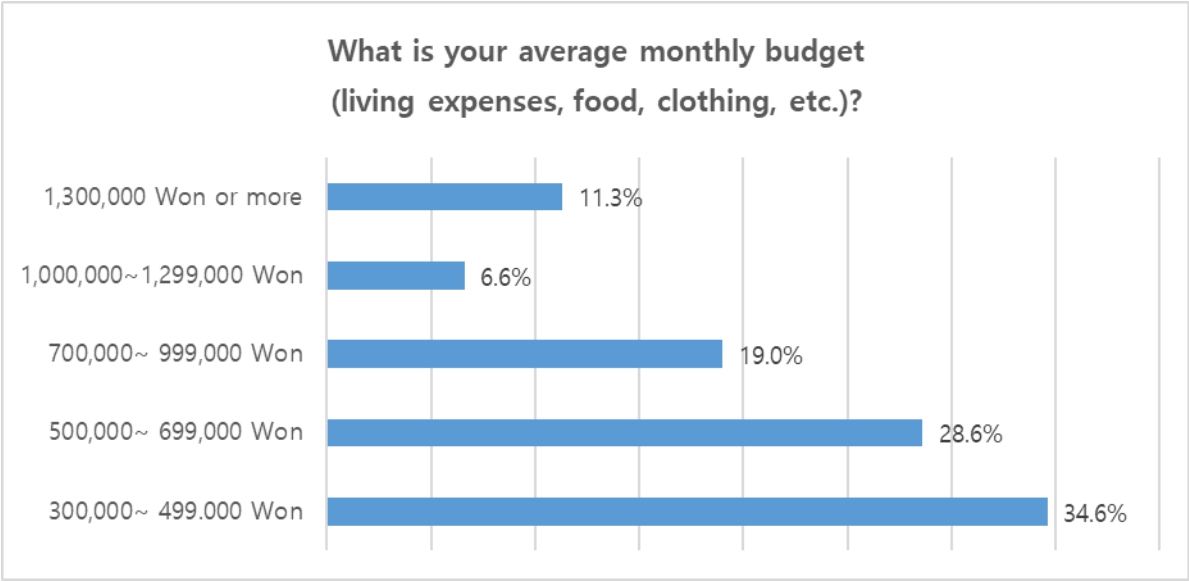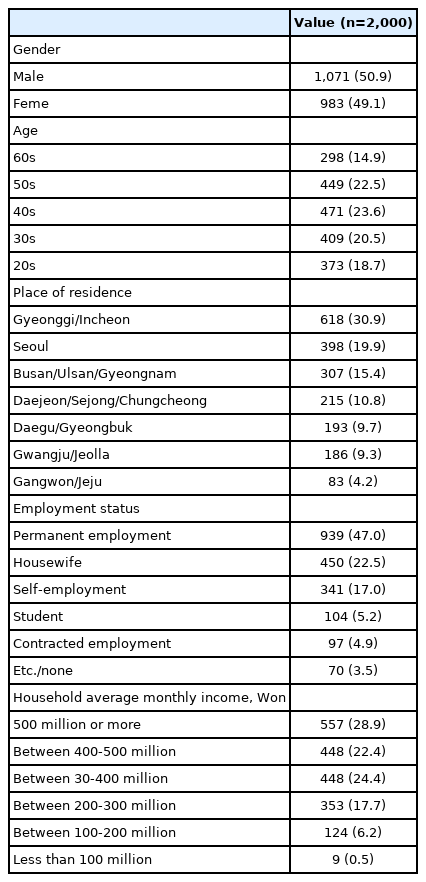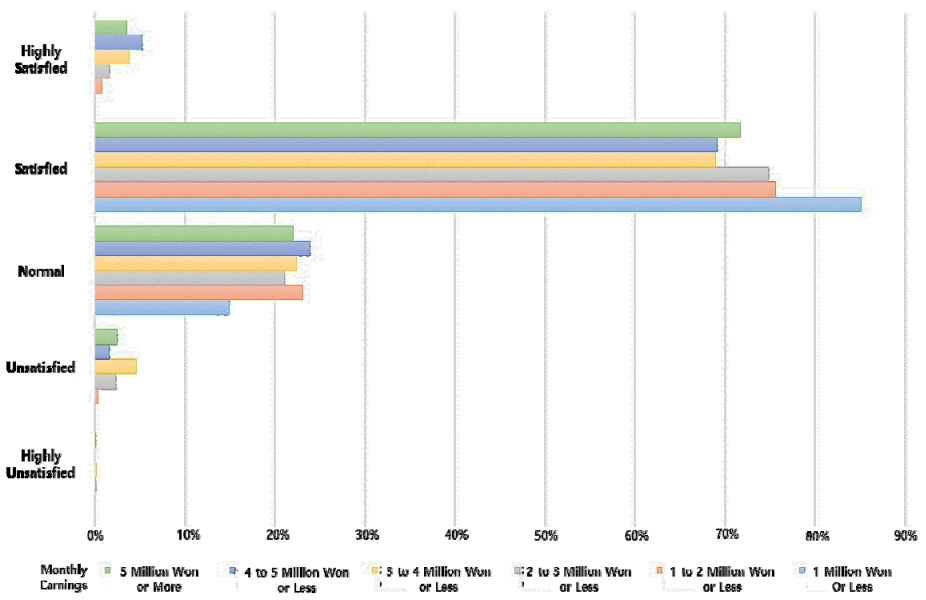국민건강보험제도에 대한 국내 유학생의 인식 및 의료서비스 이용현황 분석
A Study on National Health Insurance Literacy among International Students in Korea and Their Medical Service Use
Article information
Abstract
연구 배경
국내 외국인 유학생들이 지속적으로 증가하면서 보건복지부는 국내 늘어나는 외국인의 건강보험의 합리적 관리를 위해 2019년 7월 ‘외국인 건강보험제도’를 개편하여 6개월 이상 국내체류 외국인 유학생의 건강보험 당연 가입 의무화를 추진하였다. 이런 외국인 건강보험제도 개편을 통해 외국인 유학생은 받을 수 있는 의료 혜택은 크게 늘어나게 되었지만 보험료에 대한 경제적인 부담도 증가한 것이 사실이다.
방법
본 연구는 한국에 수학 중인 유학생 중 건강보험에 가입되어 있는 유학생을 대상으로 건강보험제도 인식조사를 실시하여 국민건강보험에 대한 외국인 유학생의 인식, 특성, 공공의료서비스 이용 정도, 만족도 등을 분석하고 주요 결과와 동향에 대해 고찰하였다. 또한 내국인을 대상으로 기 진행된 「건강보험제도 국민인식조사」의 결과와 유학생 조사 결과 값을 비교 분석하여 두 집단 간의 차이점을 알아보았다.
결과
연구 결과를 보면 지난 1년간 의료기관 이용 경험과 관련해서 의료기관을 이용했다고 응답한 비율은 내국인이 83.9%로 42.4%인 유학생에 비해 높게 나타났다. 또한 의료기관을 1회 이상 이용한 유학생 중에서도 응급의료 이용(4.3%)이나 입원(6.9%) 등의 위중한 상황이 아닌 외래진료(20.2%), 약국 이용(37.8%)과 같은 비교적 가벼운 증상으로 의료기관을 이용한 것으로 나타나 내국인과 차이를 보인다. 두 그룹 모두 본인의 건강 상태에 대한 판단은 긍정적인 것으로 나타났다. 국민건강보험제도에 대한 인식을 조사한 결과 내국인은 75.6%가 긍정으로 답한 반면 유학생은 16.0%만이 긍정이라고 답변했다. 유학생의 부정적 인식의 이유로는 높은 보험료 부담 때문인것으로 나타났다. 정부의 보험료 책정 방식에도 두 그룹 사이에 차이를 보였다. 내국인의 경우 소득 수준과 재산, 직업 군별 특성을 고려하여 보험료를 부과하고 있다. 하지만 유학생은 국적, 나이, 소득, 재산과 상관없이 동일한 보험료를 일괄 적용받고 있다. 외국 유학생들의 경우 다수가 젊고 건강하고, 만성 질환 유병률이 낮고, 병원 서비스 사용에 대한 인식이 낮으며, 국가 건강검진 이용률이 낮다. 따라서 현재와 같이 일률적인 보험금 부과를 진행하는 경우 보험금 납부 저항 등이 발생할 가능성이 높다고 판단한다.
결론
이번 연구를 통해 한국건강보험의 외국인 적용과 적정 보험료 산정에 대해 좀 더 많은 연구와 검토가 필요하다는 점을 확인하였다. 앞으로 외국인 유학생들의 대한민국의 구성원으로 안정적으로 정착하고, 나아가 비자 관련 정책을 통하여 우수한 인재 유치를 위하여 건강보험비용 부과에 따른 맞춤형 정책이 필요하다.
Trans Abstract
Background
This study aimed to examine international students’ perceptions, characteristics, use of public medical services, and satisfaction with the National Health Insurance System, and compared the results with the Health Insurance System Perception Survey conducted on Korean population to understand the differences between the two groups’ perceptions of the health insurance system and their use of medical services.
Methods
A survey was conducted from May 23, 2022 to June 21, 2022 to measure various data of international students related to the National Health Insurance System and analyzed the results.
Results
Most international students were in their 20s (the average age was 23±2.06 years), which showed that they were less likely to use medical services compared to Korean population in their 20s. Both Korean population and international students viewed their subjective health as generally good. Regarding the perceptions of the National Health Insurance System, 75.6% of the Korean population responded positively, while only 16% of international students responded positively. The biggest reason for the negative responses was the higher contributions compared to private health insurance, showing that financial hardship played a large role in the negative perceptions. The insurance contribution calculation methods by the Government showed differences. International students receive the same insurance contributions regardless of their nationality, age, income, or assets.
Conclusions
Through this study, it has been confirmed that further research and examination are needed regarding the application of Korean health insurance to foreign residents and the appropriate calculation of insurance contributions.
INTRODUCTION
1. Background of study
As competition among countries to attract talent intensifies due to the globalization of the international economy, the perception that human resources are the core of national competitiveness is expanding. Korea is also making efforts to attract talent through the Global Korea Scholarship at the National Institute for International Education under the Ministry of Education, and the number of invited people increased from 783 in 2018 to 1,410 in 2022 [1].
In addition, domestic universities are also putting forth efforts to survive by securing global educational competitiveness and intensively promoting policies to attract international students in addition to physical efforts, such as structural improvements and quota adjustments, to overcome the decline in admission due to the continuous decrease in the school-age population. The number of international students in Korea is rising due to the efforts of the government and universities.
As shown in Figure 1, the number of foreign students enrolled in universities nationwide has more than doubled from 86,410 in 2014 to 180,131 in 2019. In 2020, the number of international students decreased slightly to 153,361 due to quarantine strengthening in each country due to coronavirus disease-19 according to the Ministry of Justice’s statistics on arrivals and departures and foreign residents [2]. However, the number of international students in Korea is expected to continue to grow in the future.
As the number of international students in Korea continued to increase, discussions on international students’ access to healthcare started in earnest in 2019. The Ministry of Education implemented the International Education Quality Assurance System, which requires universities to directly promote the enrollment of international students in private health insurance and evaluate their enrollment rates annually [3]. As a result, most international students were enrolled in private group insurance through their schools and could access healthcare services with less financial burden.
In July 2019, the Ministry of Health and Welfare reformed the Health Insurance System for Foreigners to reasonably manage the increasing health insurance needs of foreigners [4]. Three major changes were made to the foreign health insurance system [1]. Any foreigner or overseas Korean who has stayed for 6 months or more in Korea is subject to the statutory subscription to health insurance [2]. If the income and assets of foreigners are difficult to identify, the average contribution of all National Health Insurance subscribers would be imposed. And [3] late payment would be reflected on evaluation of visa extension.
This Health Insurance System for foreigners reform has significantly increased the number of medical benefits available to international students. However, the financial burden of contributions has also increased, and universities have expressed concerns about the date of application, prompting the Ministry of Education to request a delay, which was postponed until February 28, 2021 [5].
With the grace period ending in February 2021, the Ministry of Health and Welfare made it mandatory for international students in South Korea to enroll in National Health Insurance in March 2021, including international students in the system. According to the Ministry of Education, the number of international students in Korea was 142,205 in 2018, and before the mandatory enrollment in the National Health Insurance, only about 26,000 of them had National Health Insurance, while the rest were enrolled in private insurance through their schools and paid contributions of around 10,000 won per month. Although mandatory enrollment in the National Health Insurance has expanded the scope of medical coverage compared to private insurance, the financial burden of international students has increased six to seven times [6]. The contribution rate for international students is expected to increase from 30% in 2021 to 40% from March 2022 to February 2023 and 50% from March 2023 onward, increasing the burden on international students.
This study conducted a survey on the perception of the health insurance system among international students studying in Korea who were enrolled in National Health Insurance, analyzed their perceptions, characteristics, use of medical services, and satisfaction with the National Health Insurance System, and discussed the main results and trends. We also analyzed the results of the Health Insurance System Perception Survey conducted on Korean population and compared them with the results of the international student survey to understand the differences between the two groups’ perceptions of the health insurance system and their use of medical services.
2. Research objective
This study aimed to determine the extent to which international students are aware of the necessity and details of National Health Insurance and their actual use of medical services by conducting a survey of international students in Korea who were compulsorily enrolled in National Health Insurance since March 2021. Furthermore, the study also aimed to measure the financial burden of international students according to enrollment in National Health Insurance and analyze their satisfaction with healthcare services compared to their financial burden.
Finally, by comparing and analyzing the data of international students obtained through the study with the results of the Health Insurance System Perception Survey conducted on Korean population, we aimed to determine the differences between the two groups in terms of their awareness of the health insurance system, the extent to which they utilized medical services, and their satisfaction with medical services relative to their financial burden.
METHODS
1. Research process
In this study, we conducted a survey to measure various data of international students related to the National Health Insurance System and analyzed the results. The survey used in the study was based on the Health Insurance System Perception Survey on Korean population by the Korea Insurance Research Institute in 2019 and reviewed other relevant domestic and international literature. In addition, survey questions were organized by conducting preliminary interviews with international students attending universities so that the actual situation of international students could be realistically grasped. The survey was conducted on international students staying in Chungnam Province, Korea, with National Health Insurance, who were receiving medical services.
1) Awareness of the health insurance system for international students and the status of medical service use
Based on the 2019 National Awareness Survey of the Health Insurance System, the survey was divided into three categories, taking into account the characteristics and situations of international students, and consisted of a total of 20 questions: part 1. Usage of medical services and healthcare; part 2. Awareness and satisfaction with the national health insurance system; part 3. Economic conditions and general matters for international students.
A survey of international students who expressed their intention to participate in the survey was conducted after obtaining consent for the purpose of the survey. The survey was conducted in a 1:1 interview to secure the reliability of the survey and allow international students to participate in the survey independently. We received interpretation help from a pre-trained foreign researcher to ensure the accuracy of the survey.
2) Comparison with the results of the Health Insurance System Perception Survey of Korean population
We compared the results of the 2019 Health Insurance System Perception Survey [7] conducted by the Korea Insurance Research Institute with the results of the survey conducted in this study to identify differences between Korean population and foreigners.
2. Study subjects and duration
1) Study subjects
We targeted those enrolled in a degree program at a university in the Chungnam Province of South Korea or were international students studying the Korean language and enrolled in National Health Insurance as study subjects. All of the international students participating in the study gave us written consent and voluntarily agreed to do the survey.
(1) Number of study subjects and basis for calculation
Based on the statistics of international students in domestic higher education institutions (Ministry of Education) in 2021, more than 364 out of 6,926 international students studying for university degree courses and Korean language training courses in Chungnam Province were selected as study subjects.
Sample calculation based on: n = [z2 × p × (1 - p) / e2] / [1 + (z2 × p × (1 - p) / (e2 × N))].
Margin of error: ±5%p for 95% confidence level; z = 1.96 for a confidence level (α) of 95%; p = proportion (decimal); N = population size; e = margin of error; z = 1.96; p = 0.5; N = 5810; e = 0.05. So, n = [1.962 × 0.5 × (1 - 0.5) / 0.052] / [1 + (1.962 × 0.5 × (1 - 0.5) / (0.052 × 6926))]; N = 384.16 / 1.0555 = 363.972; n ≈ 364.
2) Recruitment of study subjects
We requested that dormitories and facilities in universities, Chungnam Province used by many international students post the recruitment of study subjects on a bulletin board to find subjects willing to participate. An "explanation and consent form for study subjects" was sent by mail or e-mail to study subjects who expressed their intention to participate, and researchers visited them in person to conduct the survey.
3) IRB approval information and study duration
This study received IRB Approval from Soonchunhyang Institutional Review Board (IRB approval number: 1040875-202203-SB-046; approval date: May 16, 2022). And the survey period was from May 23, 2022 to June 21, 2022.
3. Data processing method
Statistical analyses were performed using RStudio (version 4.2.2; RStudio Team, RStudio, PBC, Boston, MA, USA), and the general characteristics, medical service utilization, and healthcare status of the study subjects were described using real numbers and percentages. Differences in survey results between nationalities were analyzed using an analysis of variance followed by Tukey post-hoc analysis. A P-value of 0.05 indicated statistical significance.
RESULTS
1. General characteristics of the respondents
As explained in Table 1, the total number of international students who participated in the survey was 364, with a gender distribution of 49.7% males and 50.3% females, maintaining a balanced representation. The average age of participating international students was 23±2.06 years old, reflecting a predominantly youthful demographic in their early twenties, which is consistent with a higher proportion of Korean language learners and undergraduate students. Among the international students, Vietnamese students accounted for the largest nationality group at 45.33%, followed by students from Uzbekistan, Mongolia, and China. In terms of academic status, 57.4% were enrolled in undergraduate programs, while 38.74% were Korean language learners. Master’s and doctoral students made up 2.75% and 4.1%, respectively. The average duration of National Health Insurance enrollment for all participants was 11±4.76 months.
2. Results of the survey
1) Part 1. Usage of medical services and healthcare
(1) Use of medical services during the stay in Korea
As shown in Figure 2, of the international students who participated in the survey, 57.7% had never used medical institutions, such as hospitals or pharmacies, in the past year. Therefore, the frequency of international students using medical institutions was low. Among the international students who used medical institutions more than once, they were used for relatively mild symptoms, such as outpatient services (20.2%) and pharmacy (37.8%), not for critical situations, such as emergency medical services (4.3%) or hospitalization (6.9%). Notably, 26.6% of medical institution users were interested in checking their health status using the advanced medical system after entering Korea.
(2) Difficulties in using medical services
When asked if they ever needed medical treatment or a checkup but did not get it, only 18.7% said yes. In terms of reasons, 45.5% of the respondents said that they were burdened by medical expenses, while 17.0% and 17.9% said that they did not know how to use it and did not have time because of studying and part-time jobs, respectively. Another 17.9% of the students said they were simply afraid of going to the hospital or were afraid to communicate in Korean. In summary, even though medical treatments were needed, they failed to go to hospitals, mainly because of the financial burden. And not knowing how to use medical services and being afraid of communicating in Korean were also significant reasons.
(3) Health condition and healthcare
As for their health condition, 53.0% of students answered that their health condition was better than “good,” 44.2% of the students answered “average,” and most of them (97.2%) answered that they were “above average.” This is consistent with the result that 57.6% of the students had not used a hospital or a pharmacy in the past year. When asked if they were currently taking care of their health, 69.8% of students said they were, indicating a high level of interest in health. They said that they managed their health by exercising, taking supplements, and improving their diet and habits.
2) Part 2. Awareness and satisfaction with the National Health Insurance System
(1) Perception of applying National Health Insurance to international students
Regarding the application of the National Health Insurance System to international students, 16.0% of the international students answered positively, 38.0% answered negatively, and 46.2% answered neutrally (no opinion). By country (region), international students from Southeast Asia, such as Vietnam and China, thought more positively than those from Central Asia, such as Uzbekistan and Mongolia, and students in language training courses were more positive than those in degree courses. Students who thought positively said that the financial burden of medical expenses was reduced compared to the expansion of medical service benefits, while 91.2% of students who thought negatively said they were dissatisfied with higher insurance contributions compared to private health insurance.
(2) Understanding the National Health Insurance System
Among international students, 89.6% of them said they were informed about the health insurance system in advance, and 95.7% said the most common source of information was their university’s international office. In addition, 78.6% of the students responded that they had a good understanding of the National Health Insurance System, including the scope of coverage, the level of coverage, and eligibility, indicating that they had a relatively good understanding of the system.
(3) Perception of insurance contributions
Regarding monthly insurance contributions, 74.2% (negative 39.3% and 34.9% very negative), regardless of nationality, said they had a negative perception. Considering that 18.7% of the students answered that it was appropriate, only 7.1% had a positive perception, indicating that the current contribution, which was higher than the previous private health insurance contribution, was economically burdensome.
3) Part 3. Economic conditions and general matters for international students
(1) Paying insurance contributions by international students
Of the international students, 99.4% knew exactly how much their insurance contributions were, and 58.0% said they were on track with no late payments so far. Conversely, 42.0% of the students had late payments in the past year or currently had late payments. As with the perception of the health insurance system, Vietnamese and Chinese students, who had positive perceptions, paid well, while Uzbekistan and Mongolia, with negative perceptions, had a high delinquency rate. As for the reason for the delinquencies, 74.7% of the respondents said they were due to economic difficulties, showing that they felt a lot of economic burden from rising insurance contributions, as in other surveys.
(2) Economic situation of international students
Of the international students, 55.9% earned money for studying abroad through part-time jobs. In addition, 42.7% of the respondents said they were receiving financial support from their families.
Among the international students, 67.8% reported that they earned an average of 300,000 to 890,000 won per month from their part-time jobs, followed by 13.8% who earned less than 300,000 won and 14.1% who earned from 100,000 to 129,000 won. Earnings from part-time work were higher for degree students than for students in language training courses. You could examine the distribution of international students’ monthly earnings from part-time jobs by range in detail in Figure 3.
As shown in Figure 4, excluding tuition, the largest share of international students’ monthly living expenses was 34.6% of 490,000 won or less, followed by 28.6% of 500,000 to 690,000 won and 19.0% of 700,000 to 990,000 won, demonstrating that most international students spent one million won or less per month. By course, students in degree courses spent less than students in language training courses, and the longer they stayed in Korea and the more fluent they were in Korean, the less they spent.
When all international students in Korea were asked about their economic status, 35.0% of them answered that they were in the middle, and 56.0% said they were below the middle, indicating a negative view of their economic situation.
3. Differences in the perception of the health insurance system and the use of medical services between the two groups of Korean population and international students
1) General characteristics of Korean population
The 2019 Health Insurance System Perception Survey was conducted on a total of 2,000 people, of which 1,017 (50.9%) were male and 983 (49.1%) were female. The general characteristics of the respondents were as Table 2.
By age, 471 respondents (23.6%) were in their 40s, followed by 449 (22.5%) in their 50s, 409 (20.5%) in their 30s, 373 (18.7%) in their 20s, and 298 (14.9%) in their 60s.
In terms of residence, 618 (30.9%) lived in Gyeonggi/Incheon, 398 (19.9%) were from Seoul, 307 (15.4%) were from Busan/Ulsan/Gyeongnam, 215 (10.8%) were from Daejeon/Sejong/Chungcheong, 193 (9.7%) were from Daegu/Gyeongbuk, 186 (9.3%) were from Gwangju/Jeolla, and 83 (4.2%) were from Gangwon/Jeju.
In terms of employment status, 939 respondents were full-time employees (47.0%), followed by 450 housewives (22.5%), 341 self-employed workers (17.0%), 104 students (5.2%), 97 temporary workers (4.9%), and 70 other/unemployed (3.5%).
When looking at the distribution of average monthly household income, 577 respondents (28.9%) earned more than 5 million won, 488 respondents (24.4%) earned between 300 and 400 million won, 448 respondents (22.4%) earned between 400 and 500 million won, 353 respondents (17.7%) earned between 200 and 300 million won, 124 respondents (6.2%) earned between 100 and 200 million won, and 9 respondents (0.5%) earned less than 100 million won, showing that more than 93.3% of survey respondents earned more than 2 million won.
2) Comparison of findings between the two groups
(1) Usage of medical services and healthcare
① Usage of medical services
Regarding the experience of using a medical institution in the past year, 83.9% of Korean population said they had visited medical institutions compared to 42.4% of international students. In terms of the types of medical service used, outpatient care and pharmacy were the most common, with no significant differences between the two groups. However, Korean population were more likely to use medical institutions for health checkups (39.7%) than international students (25.6%).
For Korean population, the older the age, the more likely they were to use a medical institution (94.0% in their 60s, 91.4% in their 50s, and 86.1% in their 40s), but the average age of the international students was 23, which may explain why younger international students were less likely to use a medical institution (57.6% of international students had not used a medical institution in the past year).
In terms of unmet medical needs (whether they could receive medical treatments or tests when they thought they needed those in the past year), only 3.9% of the Korean population said they had an experience, while 80.4% said they had not (15.7% said they never needed care or tests) as shown in Figure 5. This was significantly different from international students, where 18.7% reported having unmet healthcare needs.
Among the reasons for unmet medical needs, 57.8% of the Korean population reported time issues, followed by 31.6% who did not want to wait for a long time, and 29.4% had economic reasons, while 45.5% of the international students reported economic reasons due to medical expenses, and 17.0% and 17.9% cited not knowing how to utilize it and a lack of time due to studying and part-time jobs, respectively. However, among Korean population, the lower the monthly income level (16.2% under 1 million won → 3.6% over 5 million won), the higher the rate of unmet medical needs, suggesting that financial burden was a common cause of unmet medical needs among the lower income group.
② Subjective perception of health conditions
Both Korean population and international students viewed their subjective health as generally good. As for Korean population, 77.2% (17.7% very good, 59.5% good) said that their current health was good, 19.9% said neutral, and 2.9% said poor (0.0% very poor). For international students, 53.0% of the students rated their health as better than good (20.3% very good, 32.7% good) and 44.2% rated it in the middle (neutral), indicating that most students perceived their health condition as above average.
The percentage of respondents who were taking care of their health was 64.1% for Korean population and 69.8% for international students. Of the Korean population in their 20s, 49.8% reported that they were taking care of their health, which was lower than that of international students (average age 23).
(2) Perception of the National Health Insurance System
When asked about their perceptions of the National Health Insurance System, 75.6% of the Korean population responded positively (personal need), while only 16.0% of the international students responded positively (38.0% negative, 46.2% neutral (no opinion). The biggest reason for the negative response was higher contributions (91.2%) compared to private health insurance, showing that financial hardship played a large role in negative perceptions.
(3) Satisfaction with the health insurance system
① Korean population’ satisfaction based on average monthly gross income
The results of the Korean population’ satisfaction survey, which centered on the affordability of insurance contributions, coverage, and the quality of administrative work, showed that when the average monthly gross income was divided into five groups by 1 million won, the lowest income group of under 1 million won showed the highest satisfaction (3.9 on a 5-point scale), as shown in Figure 6. Public satisfaction with the health insurance system by average monthly gross income.
For Korean population, higher satisfaction in the lower income group may reflect the fact that they could get more medical benefits relative to the contributions they paid. This is different from the fact that only 16.0% of the international students responded positively to the application of the National Health Insurance System to international students, which can be inferred to reflect the burden of insurance contributions on international students compared to the low frequency of medical visits.
DISCUSSION
1. Discussion by subtopics
1) Usage of medical services and healthcare
(1) Usage of medical services
Data on medical institution utilization by Korean population showed that the frequency of use was highly correlated with age.
When asked, "Have you ever used a medical institution, such as a hospital or pharmacy, in the past year?" 42.4% of the international students answered yes, and 57.6% answered no. Most international students were in their 20s (the average age was 23±2.06 years), which showed that they were less likely to use medical services compared to Korean population in their 20s (67.7%). This may be due to the fact that many international students studying in Korea come from countries with less developed medical systems or with lower levels of medical services than Korea, and their perception of higher barrier to accessing healthcare in their home country was maintained in Korea.
While 3.9% of the Korean population and 18.7% of international students reported that they experienced unmet medical needs in the past year, there was a significant difference in the percentage between the two groups, with an even greater difference in the reasons for unmet medical needs. For Korean population, the biggest reason was that they were not willing to wait for a long time. For International students, financial reasons due to medical expenses topped the list.
(2) Healthcare
Both Korean population and international students viewed their subjective health as generally good. When asked about their current health, 77.2% of the Korean population reported good and better, while 53.0% of international students reported good and better. As 44.2% of the international student responded neutrally, most international students considered their health to be above average.
A similar number of Korean population and international students’ respondents said they were managing their health (64.1% for domestic students and 69.8% for international students). However, in a direct comparison of people in their 20s in both groups, Korean population stood at 49.8%, showing that international students were taking better care of their health.
2) Perception of the National Health Insurance System
When asked about their perceptions of the National Health Insurance System, 75.6% of the Korean population responded positively, saying, “The system is required”(personal need), while only 16.0% of international students responded positively (38.0% negative, 46.2% neutral (no opinion). The biggest reason for the negative responses was the higher contributions (91.2%) compared to private health insurance, showing that financial hardship played a large role in the negative perceptions.
3) Economic situation of international students
Of the international students, 55.9% earned money for studying abroad through part-time jobs. For international students, 67.8% of them reported that they earned an average of 300,000 to 890,000 won per month from their part-time jobs, followed by 13.8% who earned less than 300,000 won, and 14.1% who earned from 100,000 won to 129,000 won.
Excluding tuition, the largest share of international students’ monthly living expenses was 34.6% of 490,000 won or less, followed by 28.6% of 500,000 to 690,000 won and 19.0% of 700,000 to 990,000 won, demonstrating that most international students spent 1 million won or less per month.
When all international students in Korea were asked about their economic status, 35.0% of them answered that they were in the middle, and 56.0% said they were below the middle, indicating a negative view of their economic situation.
2. Study limitations
1) Geographic limitations of the study participants
This study was limited to international students studying at universities in the Chungnam Province, which implies regional limitations. Considering the different distribution of international students by region, the number of students per country, and the number of students per course, the results of this study may be limited to international students in Chungnam Province.
2) Different survey timing in the two groups
(1) Different Health Insurance System perception survey timing
Korean population were surveyed between August to September 2019, and international students were surveyed between May to July 2022, resulting in a time lag of approximately three years between the two surveys. In conclusion, Korea’s health insurance is a system in which all citizens enroll in health insurance, pay for medical expenses, and receive insurance benefits. Citizens pay monthly health insurance contributions. However, several aspects should be considered to analyze the fairness of imposing health insurance contributions on international students.
The Korean health insurance system charges different contributions for different occupations, including workers, self-employed, and government officials. Contributions can be imposed in two ways: by charging a contribution proportional to an individual’s income or by determining an appropriate contribution and charging a portion of it based on the individual’s occupation. These ways take income levels and occupational characteristics into account and are generally considered to be fair. However, in the case of international students, it is difficult to accurately identify income from part-time jobs, etc., and when the work is done other than during legal working hours, it is difficult to verify income because wages could be paid in cash.
Contributions are imposed differently by economic status in South Korea. The system is structured for higher-income earners to pay higher contributions and for lower-income earners to pay lower contributions. By doing so, it aims to reduce the burden on economically vulnerable people and ensure that they pay their fair share. When determining contributions, ownership of a vehicle or a house is considered as well. However, when it comes to most international students studying in Korea from other countries, with the exception of Chinese students who have family support for their tuition, the differences in the economic power of the countries need to be taken into account. For example, the average income of a middle-class family in Uzbekistan should be set as a standard value, and it should be compared to that of major countries such as Mongolia and Vietnam. Contributions should vary based on an economic assessment of Korea.
Korean health insurance provides some coverage for medical services to those who pay contributions. This makes it more affordable for citizens to get the medical services they need. Benefits vary according to the types of medical services and are continually reviewed and improved in accordance with the National Health Insurance Act. Most international students are young and healthy, have a lower prevalence of chronic diseases, a lower awareness of using medical services, and a lower percentage of medical checkups. While they have a high demand for medical services related to dental care, emergency care, and the common cold, they are less likely to use medical services for treating chronic diseases, which affect heavily on health insurance finances. Thus, resistance to paying is highly likely if uniform contributions are imposed.
Therefore, the above factors should be considered to determine the fairness of charging for health insurance contributions.
It is also necessary to study other countries’ health insurance contributions for Korean population studying in foreign countries, such as the United States, Canada, Australia, etc., and prepare measures to promote the health of Korean population.
This was a general discussion of fairness, and further review and analysis in specific situations are required. Going forward, customized policies on health insurance contributions are needed to ensure that foreign students are able to integrate as members of the Korean community and that foreign talent can be attracted through visa-related policies.

